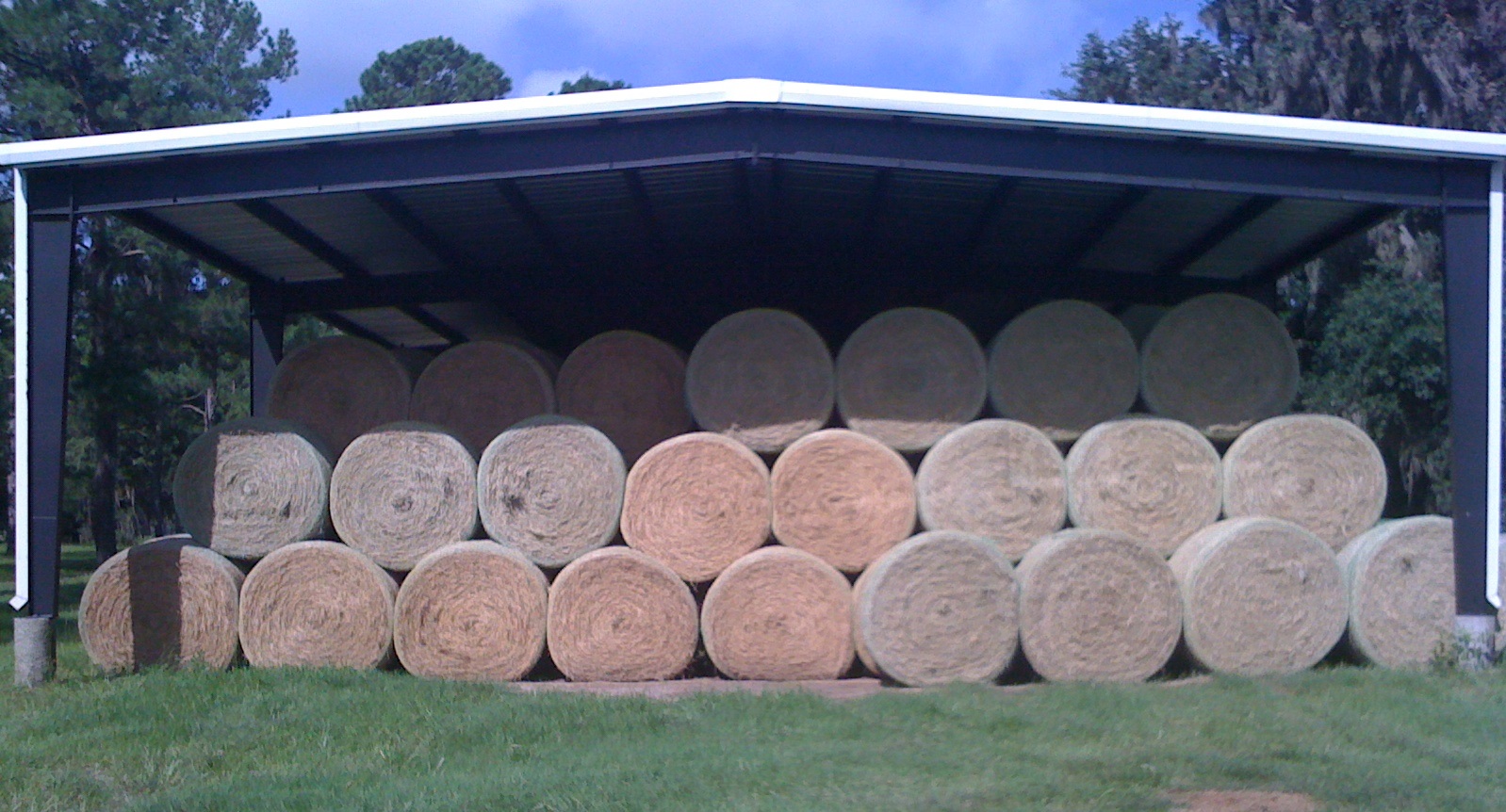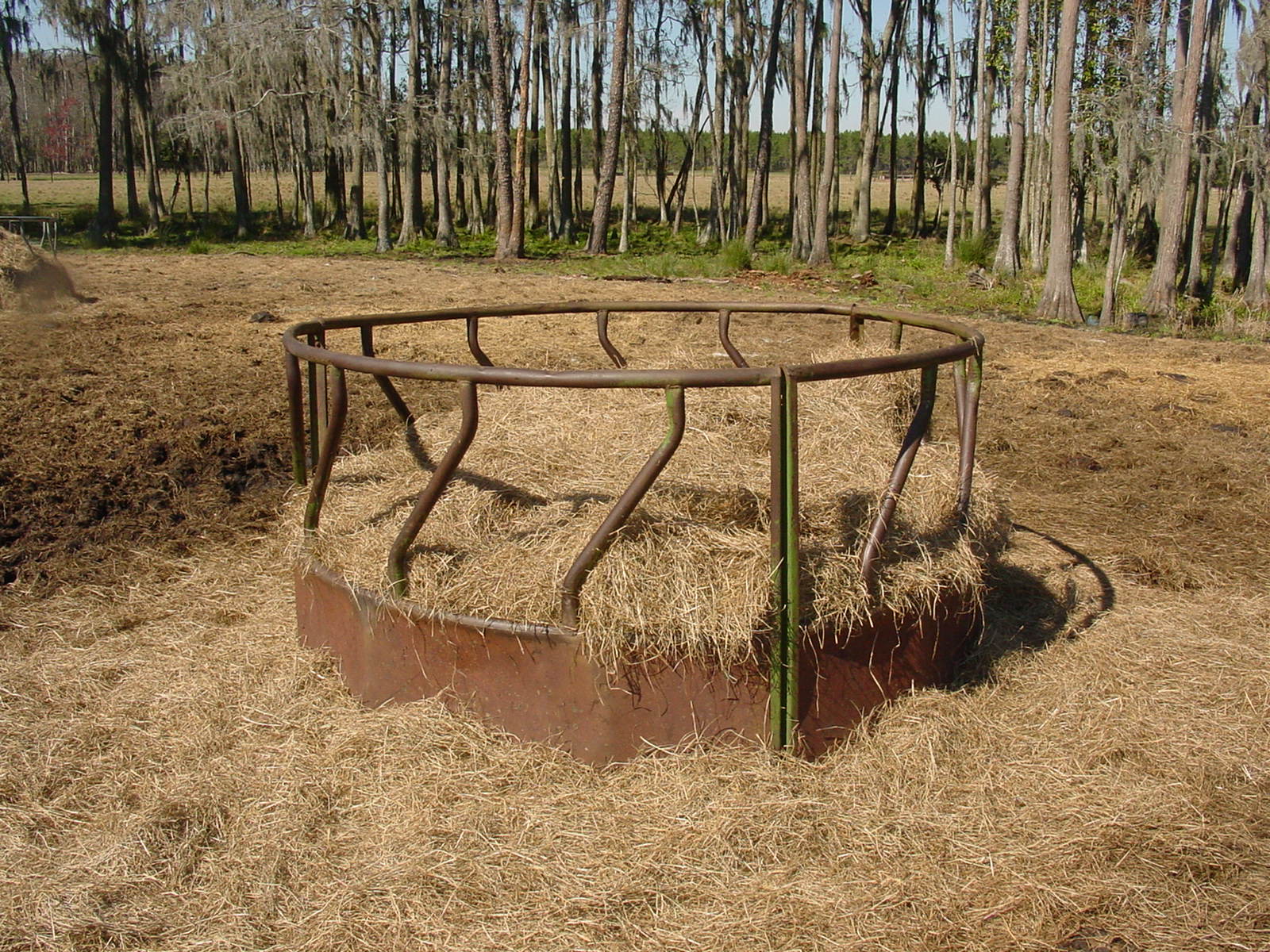
Well-made, dense hay bales maintain their quality during storage and decrease the amount of wasted hay and dollars during the winter feeding period. (Alachua, Florida)
Hay feeding is a common practice for many beef cattle enterprises in North Florida. The key question is, are you getting all of the value you expected out of that bale of hay? Multiple factors affect the value and profitability surrounding hay feeding of beef cattle. Too often, if hay is purchased, it is purchased on a $/bale basis rather than $/pound basis. The variation in the weight of bales is the first issue to address. Consider a 1,000 lb bale priced at $40/bale as the basis for comparisons; an 800 lb bale purchased for the same $40 costs 25% more on a dollar per hundred weight basis. Many cattle producers assume they are buying 1,000 lb large round bales, and more often then not, they are wrong. In fact, they are receiving much smaller bales and, as a result, more expensive hay bales. Thus, the cost to provide hay is even greater because additional bales must be purchased to meet the needs of the herd.
Large round bales come in a number of different dimensions, couple that with differences in density, and bale weight becomes a moving target. We buy and sell cattle based on weight, why not hay? Next consider nutritional value measures of Total Digestible Nutrients (TDN) and Crude Protein (CP), two important nutritional inputs for the cow herd. Nutritional information can be obtained from a forage test, which is one of the best investments a racnher can make. Accurate decisions about nutrition can’t be made without a forage test. Using our 1,000 lb, $40 bale; every 2% decrease in TDN% equates to a $0.30 increase in the dollar per hundred weight price of energy supplied; so if our basis bale is 55% TDN, a bale that is 45% TDN will cost 22% more on an energy supply basis. Meanwhile every 1% decrease in CP% equates to a $6.37 increase in the dollar per hundred weight price for protein supplied; if our basis bale is 10% CP, a bale that is 5% CP cost 100% more on a protein basis. Generally, hay is not fed to meet the protein needs of cattle, but low-quality hay ultimately costs extra money, because more supplemental feed is required to meet nutritional requirements.
So how does a cattle producer get the information regarding hay bale weight and nutritional content? Hay bale weights can be obtained by weighing a representative subsample of the hay bales that are purchased in every load. Next take a hay sample of those bales. Work with your local extension agent to facilitate the hay analysis and interpretation.

Poorly made, low-quality hay is wasted in greater amounts leading to increased winter feeding costs and environmental issues that can be avoided with forage testing and proper hay feeding management. (Gainesville, Florida)
Now consider that cows do not consume every pound of hay offered to the herd, so there is some waste. Hay waste is inevitable, but is increased by feeding low-quality forages, and inadequate hay feeding management. Hay waste comes from two sources: storage loss and feeding loss, both of which are affected by the management decision of the cattle owner. Very often the wasted hay is not included in the total cost of a hay feeding program. Hay bales with low TDN and CP increase the likelihood of greater amounts of hay wasted, so let’s look at the economic outcome of hay waste. Using our 1000 lb, 51% TDN, 8% CP hay bale, a minimal waste figure of 10% increases the TDN cost of hay by $0.87 per hundred weight. Unfortunately a figure of 30% waste is not uncommon, which increases energy price by $3.36 per hundred weight of TDN. Similarly 10 % hay bale waste increases CP costs by $5.57 per hundred weight, but a 30% waste figure increase CP cost to $21.43 per hundredweight of protein.
Steps to cut down on hay waste:
-
Make or buy well-made bales that are dense. These shed water best and resist weathering losses.
-
Store hay in the proper way, under a roof is best, but if that is not possible, on well-drained soil in a north-south orientation, stacked tightly end-to-end.
-
Feed hay in a manner that decreases the cow’s opportunity to waste the hay (use hay rings, cone feeders, or unroll the bale).
Hay feeding is an important part of many cattle operation’s winter feeding program. All too often cattlemen are inadequately informed about the product that they are purchasing or producing. Lost opportunities regarding bale size, nutritional content, and waste occur because we don’t weigh bales, take forage samples, or consider how to feed the hay. At a time of record calf prices and return to the cattle enterprise, controlling hay costs can squeeze out even higher profits.
The following publications provide more information:
Minimizing Losses in Hay Storage and Feeding
Florida Cow-Calf Management, 2nd Edition – Feeding the Cow Herd
- Clemson Virtual Southeast Cow-Calf Conference – November 11-12 - November 6, 2020
- Dispelling Cattle Mineral Supplementation Myths - November 15, 2019
- What Influences Profit for the Beef Cattle Enterprise? - June 3, 2019
